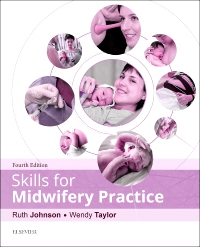
Skills for Midwifery Practice - Elsevier eBook on VitalSource, 4th Edition
Elsevier eBook on VitalSource

Now $42.29
Now with a new design, the ever popular Skills for Midwifery Practice continues to provide the ideal level of instruction and guidance for a wide range of clinical skills, each one of which is presented in a unique, template format to help make learning easy.
Step-by-step guidance is given on a range of topics including abdominal examination, taking of maternal and neonatal vital signs, infection control, mother and baby hygiene, elimination and drug administration. Childbearing and intrapartum skills are also extensively covered as are neonatal assessment and nutrition, principles of phlebotomy and intravenous therapy, moving and handling, wound management and CPR.
Skills for Midwifery Practice is invaluable to midwives in training, qualified midwives returning to practice, as well as other members of the obstetric healthcare team.
Newer Edition Available
Skills for Midwifery Practice - Elsevier eBook on VitalSource
-
- Presents over 150 essential midwifery procedures in an easy-to-read, quick reference format
- ‘Learning Objectives’ and ‘end-of-chapter’ self-assessment exercises allow readers to monitor their progress
- Refers to the latest evidence and research, including current national and international guidelines
- Explains the underlying physiology associated with pregnancy and childbirth
- Over 150 artworks help explain physiological processes and clinical procedures
- ‘Roles and Responsibilities’ boxes define the nature and extent of current practice
- Ideal for use as a basis for teaching and assessment
-
- New format - now with colour - makes learning even easier!
- Explores the use and significance of the Modified Early Obstetric Warning Scoring Chart
- Discusses advances in equipment usage including the application of sequential compression devices, temporal artery thermometers, and pulse oximetry in the early detection of critical congenital heart disease
- Contains advances in microbiology and infection control including the application and removal of gloves and the use of ANTT for each relevant procedure
- Physiology updates include an expanded section on normal and abnormal breathing patterns, the structure of the stratum corneum at birth and the factors that affect its barrier function, and neonatal reflexes present at birth
- Updated information regarding the use of the automated external defibrillator during maternal resuscitation, and the use of blended air and oxygen and pulse oximetry during neonatal resuscitation
- Care of the traumatised perineum - including expanded discussion of modern suture materials
- Recognition and management of complications associated with infusion therapy and epidural analgesia
-
Chapter 1 Principles of abdominal examination: during pregnancy and labour
Chapter 2 Principles of abdominal examination — during the postnatal period
Chapter 3 Assessment of maternal and neonatal vital signs — temperature measurement
Chapter 4 Assessment of maternal and neonatal vital signs - pulse measurement
Chapter 5 Assessment of maternal and neonatal vital signs - blood pressure measurement
Chapter 6 Assessment of maternal and neonatal vital signs - respiration
Chapter 7 Assessment of maternal and neonatal vital signs - neurological assessment
Chapter 8 Principles of infection control — standard precautions
Chapter 9 Principles of infection control - Hand hygiene
Chapter 10 Principles of infection control — principles of asepsis
Chapter 11 Principles of infection control - obtaining swabs
Chapter 12 Principles of hygiene needs — for the woman
Chapter 13 Principles of hygiene needs for the baby
Chapter 14 Principles of elimination management – micturition and catheterisation
Chapter 15 Principles of elimination management -urinalysis
Chapter 16 Principles of elimination management - defaecation
Chapter 17 Principles of elimination management — obtaining urinary and stool specimens
Chapter 18 Principles of drug administration — legal aspects, pharmacokinetics and anaphylaxis
Chapter 19 Principles of drug administration — oral administration
Chapter 20 Principles of drug administration — injection technique
Chapter 21 Principles of drug administration — administration of medicines per vaginam
Chapter 22 Principles of drug administration — administration of medicines per rectum (P.R.)
Chapter 23 Principles of drug administration: intravenous drug administration
Chapter 24 Principles of drug administration — inhalational analgesia: Entonox
Chapter 25 Principles of drug administration - epidural analgesia
Chapter 26 Principles of drug administration — transcutaneous electrical nerve stimulation
Chapter 27 Facilitation of skills related to childbearing: optimal fetal positioning
Chapter 28 Facilitation of skills related to childbearing: Cusco speculum use
Chapter 29 Facilitation of skills related to childbearing: membrane sweep
Chapter 30 Principles of intrapartum skills - first-stage issues
Chapter 31 Principles of intrapartum skills: second stage issues
Chapter 32 Principles of intrapartum skills: third-stage issues
Chapter 33 Principles of intrapartum skills: examination of the placenta
Chapter 34 Principles of intrapartum skills: perineal repair
Chapter 35 Principles of intrapartum skills — management of birth at home
Chapter 36 Principles of intrapartum skills — management of labour and birth in water
Chapter 37 Assessment of the baby: assessment at birth
Chapter 38 Assessment of the baby - daily examination
Chapter 39 Assessment of the baby — capillary sampling
Chapter 40 Assessment of the baby: developmental dysplasia of the hips
Chapter 41 Principles of infant nutrition — breastfeeding
Chapter 42 Principles of infant nutrition — cup feeding
Chapter 43 Principles of infant nutrition –decontamination of feeding equipment
Chapter 44 Principles of infant nutrition — formula feeding
Chapter 45 Principles of infant nutrition — nasogastric feeding
Chapter 46 Principles of phlebotomy and intravenous therapy — maternal venepuncture
Chapter 47 Principles of phlebotomy and intravenous therapy — intravenous cannulation
Chapter 48 Principles of phlebotomy and intravenous therapy: intravenous infusion
Chapter 49 Principles of phlebotomy and intravenous infusion — blood transfusion
Chapter 50 Principles of manual handling
Chapter 51 Principles of perioperative skills
Chapter 52 Principles of wound management — healing and care
Chapter 53 Principles of restricted mobility management: pressure area careChapter 54 Principles of restricted mobility management: prevention of venous thromboembolism
Chapter 55 Principles of cardiopulmonary resuscitation: maternal resuscitation
Chapter 56 Principles of cardiopulmonary resuscitation: neonatal resuscitation


 as described in our
as described in our 